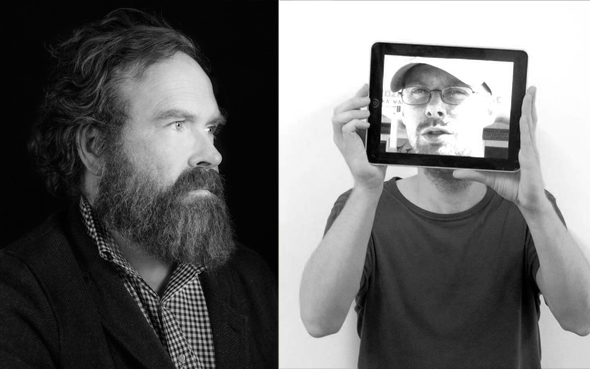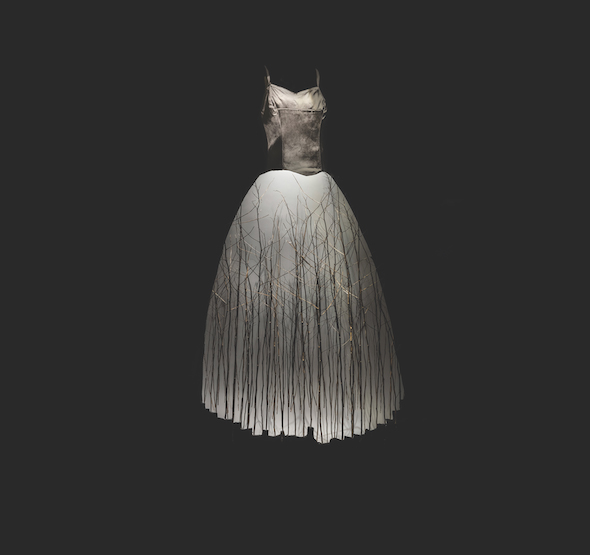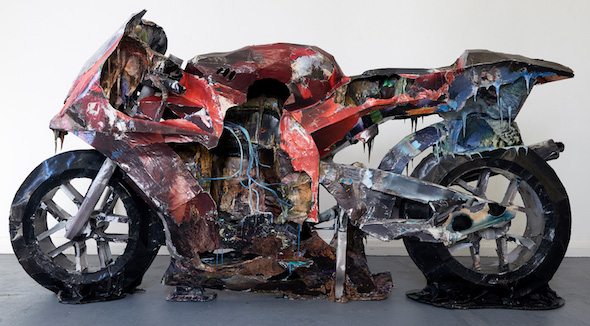
On one October weekend, the Lower East Side’s Marc Straus Gallery opened its doors with celebration for the release of two of its new artist exhibitions—Chris Jones and Todd Murphy. Both artists are creative genii of their own profession, Jones—a native of London and Murphy, a Chicago domestic and New York transplant via Atlanta. Both could not be any more different—unique in how their trades communicate their personal statements, yet they relate by sharing a vision for using art as a tool that excites the imagination.
Chris Jones works with sculpture. In his recent exhibition titled “The Apartment Series”, the artist turned the first floor of the lower Manhattan gallery space into a wonderland for his guests—stirring their mind to wonder in contemplation about various collages concerned with possessions of the modern world. Jones built this collection of work through sculptures of replicating home life environments, with scenes of societal pollution and images of an eroding human psyche. The latter, a duo polymer varnished magazine image entitled “Plot Twist” and “The Somnambulist,” initiate a reverie that obsesses over thoughts of the human identity in the modern world. The conjunction between collage framed and sculptured serve to unanimously build blocks toward defining the human existence through the power of the mind. The collage affect made of a juxtaposition of magazine clippings supports Jones’ chaotic story.
Scale the stairs of the gallery up to the second floor and enter into whole new world to find Todd Murphy’s interest in the natural world. In this space, humanity submits its egocentrism to play its role in the scheme of the world. In this concrete narrative, images of a “dress” reoccurred in variations so to illuminate past and present modes of expression. Murphy illustrates how constructs of identity in the human world are defined as a cog in the machine.
Paintings are his pride—with a focus on oil painting Murphy launched a perspective intrigued with humanities’ influence on the natural world—travel expressed through the arts and literature, specifically notifying Ulysses as a wealth of inspiration.

And similarly to Joyce, an artist of many trades, open to receiving inspiration from different concentrations in life as his pen designates his art, Murphy works with different objects of materials including oil paint, photography, and raw material—tree branches to create and define his art.
Spirituality resounds its presence throughout this collection. In the stillness that overwhelms the space of this instillation, Gracious, a 108 x 180 inch oil painting beacons the atmosphere. In this piece, a tiger occupied in its own reality is caught in the act of pouncing, far and beyond the scene. He is a creature made one with nature: the painting technique unites the animal and its environment within a plain of high grass. In the animal’s path of attack is God’s most trusted creation—she kneels innocently, victim to her fate without power or control.
Murphy’s use of multi-media materials including sculptures and paint as an art medium to share his ideas concerning the 19th Century Naturalist Period, a movement in which the union between the natural and spiritual world. The human concept of self finds itself at the mercy of life and its various forces: wildlife, nature, societal constructs including transportation and dress. All images shed light on the human existence.

In one installation, a metal bodice hangs by a string, planted by a metal fixture: the bodice is a piece of fashion accompanied by a twig-built skirt. A tea light shinning from the ground illuminates this piece against white walls. The significance of this piece stands as a solitary piece of work that introduces a series of five panels named “Starlings.” These 86-inch tall installations carry a story: one that is an experience similar to looking through a snow globe to see sights of a ship and her sails, two forest scenes: one of day, and the other, night. The last piece depicts the technicality of dressmaking through exposing the intertwining spinning of thread that would create a dress. Together, these perspectives all point toward a mix-media painting of a deer. The painting placed front-and-center of the room, filling the space with extravagance, as the animal’s antlers exaggerate past the painting by the tree branches grazing on the wall. Plain, simple and unharmed, the animal is adorned and illuminated to distribute the peace that overwhelms the space.
Other pieces of art included a table placed in the center of the second room—a three roomed spaced exhibit—features of the table resemble tree bark. In this room a picture of a deer caught in its own forest habitat, standing alone, distracted, or concentrating on something that cannot be seen in this perspective. The atmosphere is simple, dim in color and decorated with snowy accents. The trees appear dead, but they bring the image to life.
The nature of both works express interest in examining society through physical constructs. For Chris Jones, this focus is unwavered from the home and profession, as Todd Murphy evaluates the creatures and materials—ships, clothing and furniture that fabricate society as juxtaposed with the inherent peace found independent of these foundations. Murphy’s influence of Europe’s most mysteriously notorious introspective contemplators brings a full circle to the existence of his work. This exhibition represents a continuation of their perspective—a romance to understanding creation in the modern world.
TEXT BY VALERIE MCPHAIL

